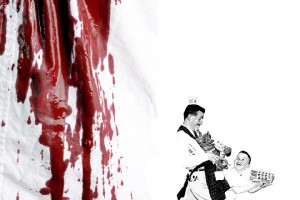« Reviews, Uncategorized
Arnaldo Simón and the disturbing images of Artvertising
Contemporary Art Space Kunsthaus Miami
By Joaquín Badajoz
Cuban-American artist Arnaldo Simón has brought to another stage his bad readings of Joseph Kosuth’s narrative, becoming a new agent provocateur, recycling vintage advertising in his photomontages and digital prints. Following his personal path between formalism and conceptualism, he has merged in the same bi-dimensional plane a work of art -given that he uses excerpts from advertisements that have lost their original function, converted into vestiges, idle burden of ideology, and have deconstructed themselves in useless objects of aesthetic enjoyment and nostalgia- abstract information, and a reasonable response, fabricated in the mind of the observer, in this case another artist with an extensive background in graphic design. Contrary to Kosuth, he is not trapped in the tautological essence of conceptualism, but emphasizes the inner attribute of any ‘artwork’ to be taken from one reality to another to express itself in a new morphological context playing new roles. These graphic quotations have allowed him to arrange data and reconstruct the old symbols, giving them a new significance. Simón has closed the semiotic circuit merging transmitters and receivers in the same loop, although the representation of the communicational process obviously entails the making of another new process that commences when we approach to “Mambru is gone to war,” his recent exhibition at Contemporary Art Space Kunsthaus Miami.
Simón’s artwork is related to the antiwar advertisement published in the mid-1930s in the United States, sponsored by World Peaceways, and even when his work does not express that grade of national resentment, showing more angst than disrespectfulness, some pieces used as outlines for his work contain provocative subtexts. They highlight the perpetual vocation of the artist as social commentator or political agitator, connecting periods of history with the thread of the hypertexts, and re-contextualizing the milieu from which this amazing collection of vintage ads was taken, with his personal repertoire of memories, fears and pains.
In his photomontages we find frozen soldiers, frosted hands, soldier’s boots and bleeding shirts blending together with cereal boxes, kids in costumes, toys or birthday cakes, displaying a bizarre retable of the grotesque mixed with naiveté, where the memorabilia is not used as a subject of nostalgia, but in terms of representation, as an object of reprisal. Therefore, his prints show a sense of décollage, with many layers of significance and a subtle dose of fetishism, expressed as an obsessive approach to father-son relations or the handmade work that his creations demand. Simón raises the conventional to the status of art, sewing, purchasing or reproducing memorabilia, and creating new meanings by way of symbols or images from ordinary artifacts, showing a sort of graphic gratification as he exposes a complex angle in a fake and edulcorated reality. As we surrender to the seduction of details, it is impossible to ignore the title Mambrú is gone to war, or the rhythm of same -which was played in an audio remix clip that the audience could listen to during the exhibition. One more time, in Simón’s logic, war is represented as a kid’s game, and therefore the simple is subverting the complex. Innocence grows up in ignorance; purity becomes a grotesque sense of pusillanimity, ruled by misinformation and ethical demands, a delusion that is evocative of the human dilemma during war. For it is the artist’s mission to bring to the surface the buried stories of contradictions, as a warning about the most obscure lies underlying failures and defeats.
When it comes to conceptual art, the flow of ideas is its most valuable asset, but the composition of Simón’s artwork and use of graphic resources is praiseworthy. We are witnessing the delivery and labor of a mature and focused artist who has been growing quietly into a persuasive creator of images, a humble documentalist of what I would like to call “Artvertising,” giving to the pragmatic world of commercial advertising and graphic design a disturbing meaning that is not exclusive to art.



































